It looks like you're using an Ad Blocker.
Please white-list or disable AboveTopSecret.com in your ad-blocking tool.
Thank you.
Some features of ATS will be disabled while you continue to use an ad-blocker.
48
share:
Level 2 Project - Could Bigfoot be sustained in the North American wilderness if it hypothetically existed ?
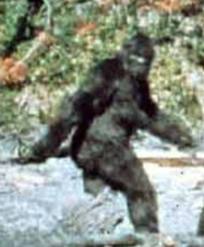
Introduction
Hey all. This research project will have a look at the infamous Bigfoot, not to see whether or not it could exist but whether or not one could be sustained in North America.
Bigfoot is one of the most well known legends of modern years with the first recorded sighting by a white man being recorded in 1811 by David Thompson when he stumbled upon some footprints which were 14 inches long and 8 inches wide with 4 toes on each foot. Ever since the myth has grown with the first widely known sighting being recorded in 1884 when a juvenile Bigfoot named Jacko was captured who was reported to have looked like a chimpanzee, although this could have been a hoax as many newspapers at the time reported false stories to amuse readers. Ever since though the legend has grown to what it is today.With countless sightings in numerous states, now there are even some crack teams assembled to go out and find this beast.
We on the other hand are not here to see whether it exists but to see if it was real could it survive in North America without being disturbed for all these years. That is what we hope to be able to answer for everyone who reads.
Project Goals
The goal of this project is to be able to definitive answer to the question posed at the beginning of the thread. To see if one of the beasts could survive in the woodlands of North America. To answer this question we will be looking into individual sightings across a number of states. The states where sightings have occurred that we will be looking into are:-
Washington, Oregon, North California, South California ( where there have been reports of the desert Squatch ), Brittish Columbia, Alberta, Florida ( Southern Florida and The pan handle ).
We will not be looking at the quality of a sighting or Bigfoot report but more the location no matter how vague, we will then look into these locations and look into what resources are around, where it is located, what food supplies are around. We will be looking into all aspects of the area and doing a lot of comparisons to known large primates such as Gorrillas.
The Research Team
Snoopie
This is me. My goals are to try and find an answer in the areas of North America i will be investigating. I will be starting with Southern Florida and post one sighting per post where i will break down the sighting to see if a large Primate could support itself in that location.
okiecowboy
This is my research partner. Their goals are to attempt to find an answer to the questions posed in the locations they choose to research. They will start by investigating Washington State, possibly the most famous area for Bigfoot sightings. He will post all findings on this forum also.
As you can see we have the same goal. Just in different areas. It is a big task this project but we feel we are up to it.
I have not allocated set states. We will complete an investigation on an area. Then take what ever one we fancy after we are done. We do not have set states as we are interested in all aspects of this project so we do not mind where we investigate.
I hope you all enjoy reading our findings.
-Snoopie
edit on 31-1-2013 by Snoopie because: (no reason given)
Southern Florida
I am posing the question, Could a Bigfoot ( Known as Swamp Ape ) or another large primate be sustained in the wilderness of Southern Florida. I will be looking at individual Incidents and sightings in Southern Florida and investigating the areas where these sightings have taken place to see if there is enough resources in these locations.
There have been sighting of this creature spanning decades with the Native Americans of the area having a strong belief in the creature. So it should be interesting to see if one could be sustained here in Southern Florida and the Glades.
Sighting One
Location : Hialeah Gardens
Location County : Dade County
Location State : Southern Florida
Sighting Date : January 1974
This sighting was vague and the person who had the sighting did not post any detail on the sighting they just reported it. Never the less this seems like as good a place as any to start looking into the environment.
So where is Hialeah Gardens on a map. Well it is on the edge of Miami in Dade county. With no woodland around apart from Slade park. Although the Trail Glades Range isn't too far away only 10 - 20 Miles away. Also the edge of Francis S Taylor Wildlife Management Area - Water Conservation Area 3B is close by only 6-8 miles away. So i will look into these to areas as they seem the most likely areas where this sighting could have possibly happened.
I will start firstly with Trail Glades Range.
Trail Glades Range
It is a small area only a couple of miles west to east. and a similar distance north to south. It is an empty baron spot with nothing but a gun range in the south west corner of it.
Here is an aerial view:
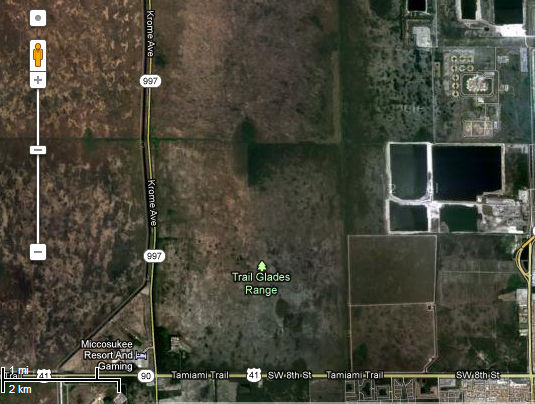
Here is a view from ground level:

As you can see from the air it looks pretty empty. But looks can be deceiving as you can see from the on the ground photo there is some pretty dense brush in Trail Glades Park. So what i ask myself is this.
Is the area big enough to support a large Primate without it being spotted apart from on this occasion? .. Well in my opinion no, The area is very small and the brush is thick but not too think that you cannot see through it with not too much difficulty and there is no-where near enough of it to let these Primates live without being seen as this area has a popular mountain bike track running through it. Also being located so close to a Gun Range i do not think the Primates would come into this location due to the loud bangs from the guns being fired. Bangs spook many animals and they do not stick around once hearing them.
Is there enough food and water in the area to support such a creature ? ... Well there is enough water here with big pools of water on the eastern side, that being said the eastern side is very close to people and Skunk Apes are not primarily reported near popular areas apart from a few rare instances at peoples remote woodland homes. As for the food i can find no evidence of any other animals that could be a food source in this area just a few birds and small animals such as rabbits. I can find no dear or anything big enough to sustain a large Primates appetite. Although large male gorillas eat 50lbs of food on average a day.
Gorillas are predominantly herbivores, eating mostly plant material. They forage for food in the forests during the day. They eat leaves, fruit, seeds, tree bark, plant bulbs, tender plant shoots, and flowers.
They have been known to eat various parts of over 200 different plant species. Occasionally, gorillas supplement their diet with termites and ants. Gorillas rarely drink water; the water contained in their diet is apparently enough to sustain them.
An average adult male eats approximately 50 pounds of food a day.
Source
But saying the Skunk Ape is only was a herbivore occasionally pigging out with ants, termites and other small critters is a possibility, but that does not sit well with me as there are many reports of Skunk Apes attacking dear and other animals. With some reports of them even storing dead deer.
The first time I saw a deer kill stash was in November of 1992 while I was investigating a cluster of bigfoot reports near the border of Stark and Carroll Counties in Ohio.
Source
So unless they are very territorial and do not like anything in their territory they must be eating these animals. So in this location there is enough food.. IF this large Primate is a herbivore of sorts.
Moving on to the second location where this sighting could have occurred.
Francis S Taylor Wildlife Management Area - Water Conservation Area 3B
This area is a lot larger than the Trail Glades and thus a lot more likely a location. It is a swampy forest that does not have a lot of human contact apart from a few air boat tours. Although there has never been a repeated sighting from one of these air boats. It is rather dense and quite a beautiful place. With long grass, swamp waters and a lot of trees. This area could easily hide something that did not want to be found. The only place of note here is the Miccosukee Hotel and Gaming Resort on the south east corner of the area. But lets go a little deeper.
Here is an aerial view:

Here is what it looks like on the ground

As you can see from the air there is a lot of water pools and dense woodland with some grassland and from the ground view you get a sense of how it looks. So i find myself asking myself the same questions.
Is the area big enough to support a large Primate without it being spotted apart from on this occasion?.. Well in my opinion yes. It is a vast area which also links to Water Conservation Area 3A and 3C so it could easily move around and with little or no human traffic apart from the occasional air boat tours and the South West 8th-Street which connects to the Tamiami Trail in the south of the area. So that being said there is a possibility that these Primates could move between these vast flat swampy areas without detection. Although there have been no sightings i can find on these roads or air boat tours. I have no reason to believe they could not live here without detection, especially if they are nocturnal like most Bigfoot investigators believe. Also i do not believe any creature would stick around to be spotted after hearing an Air Boat coming.
Is there enough food and water in the area to support such a creature ? Well I will start by looking into the food. There is an abundance of food in this area there is a lot of deer trails here out in the wilderness and lot of water birds dwelling on the waters here. Also a lot of vegetation if these Primates if they are in fact herbivores. Also with an endless supply of water for them to drink I have no reason as to why a carnivores or a Herbivore Primate could not thrive in such conditions. As we know from gorillas they like rain forest and wetland conditions with plenty of vegetation. This area provides that and could easily sustain a gorilla so there is no reason as to why another large Primate could not survive here.
This area covers some of the bases and could sustain the animal if it hypothetically existed.
I did not go into details of altitude on these areas as both are reasonably flat. Also they are low lying and not of high altitude at all.
Summary of Sighting One.
This sighting did not provide any detail so i had to try work out where it could have been and i came up with two locations within a short distance from the location on the report.
So could the Trail Glades support a large primate ? No for a number of reasons. The shooting range would spook them. A lot of traffic through the area on the mountain bike trails but no sightings and not a lot of other animals.
So could Francis S Taylor Wildlife Management Area - Water Conservation Area 3B support a large primate? I believe it could. It is dense vegetation with an abundant water supply and no lack of food. Also with not a lot of people coming here there is no reason as to why a large Primate could not live here without detection.
-Snoopie
edit on 31-1-2013 by Snoopie because: (no reason given)
Southern Florida
Sighting Two
Location : Mangrove Island in the Florida Keys
Location Description : In the middle of the Mangrove trees
Location County : Dade County
Location State : Southern Florida
Sighting Date : July 1999
This sighting is more detailed that the first. They describe a 3ft tall juvenile weighing roughly 65lbs. They claim the sighting to be deep in the Mangrove trees on the island and that they found tracks in the area and also reported a foul smell. Now there is one part of the sighting that is borderline idiotic where they state it was holding a tennis racket. As i stated earlier in my introduction post the quality of the sightings are not in question, it is the location that is in question. But never the less this is as good a place as any to investigate.
I will be looking deeper into Mangrove Island and the surrounding Islands.
Mangrove Island
So where is Mangrove Island located. Well Mangrove Island is a stunning spectacle of nature located in the Florida Keys and is listed as a Natural Marine Sanctuary. It is fairly small only roughly 1100ft in length and 600 - 700ft wide at its widest point. It has a swampy marshy ground surface with lots of thick foliage which is a good place to investigate as most Florida Skunk Ape sightings are in swampy areas.
Here is an aerial view

Here is a better view to get a lie of the land
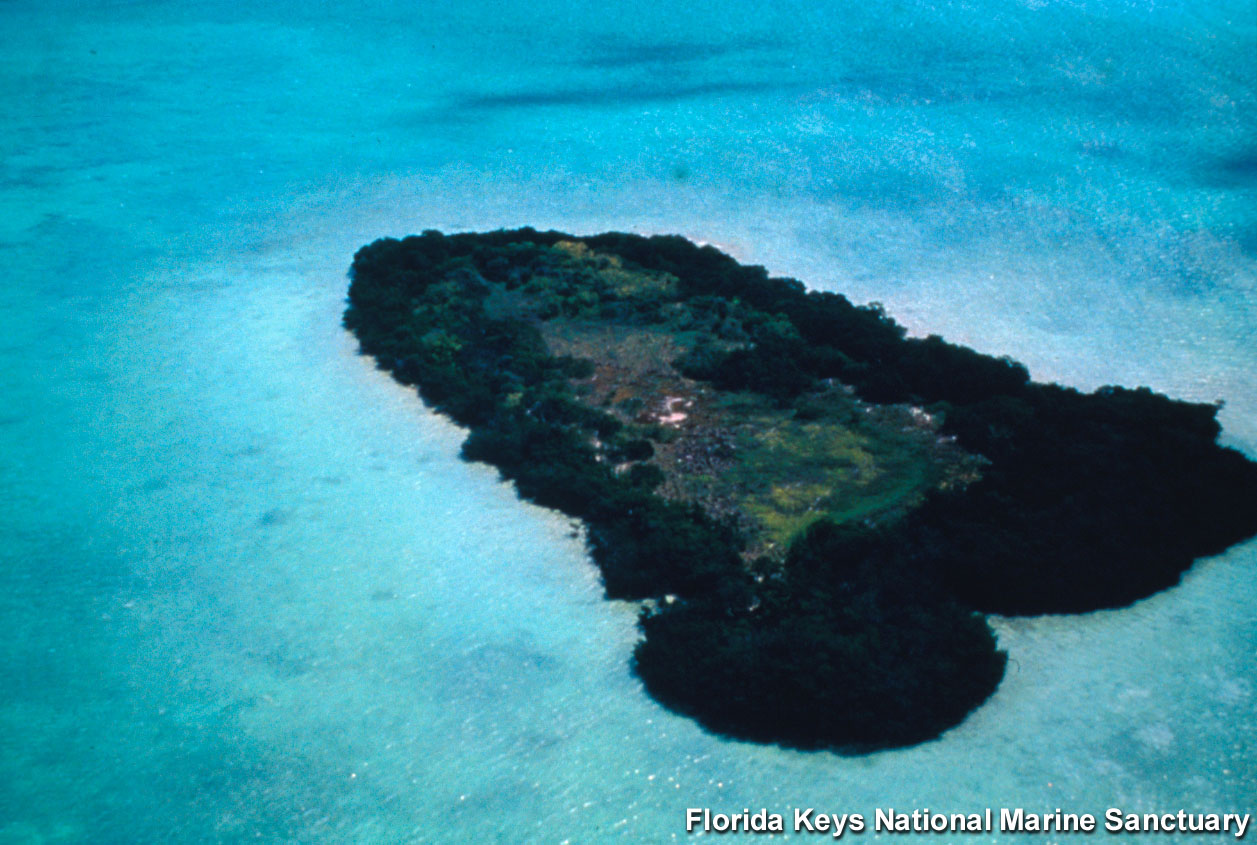
As you can see it is pretty deserted and you would need a boat to get near the island. It has very dense brush perfect for hiding in. It is very thick and full of Mangrove trees. Mangrove trees are also a great source of food as they can produce seeds or fruit which lasts a long time.
Source for Mangrove facts
But now it is time to ask myself the all important questions.
Is this area big enough to support a large Primate without it being spotted apart from this occasion ? Well in a word no. This area alone is no where near big enough to support a large Primate and since the report is of a 3ft juvenile we can speculate that there must be adults, which could not manage to hide themselves on this small island for a long period of time. Although if we were to say the can swim ( which there have been a lot of reports of them swimming near Vancouver Island in the Pacific North West. ) then there is a lot more islands around which i will look into which are easily withing swimming distance of only a couple of hundred feet. So lets look into these islands. We already know other primates can swim, so why couldn't a Bigfoot.
Primates can swim but often they only swim if they have to. Especially primates with a lot of hair eg. an ourangutan, as they dont like to get their hair wet because i becomes too heavy for their comfort.
Source
So that being said, If they had to swim these channels for food or to tend to their young, or even to relocate to a more remote area then they easily could.
So lets start by going east. A short distance east there is Fort Pierce Inlet State Park.
Fort Pierce Inlet State Park
Here is an aerial view
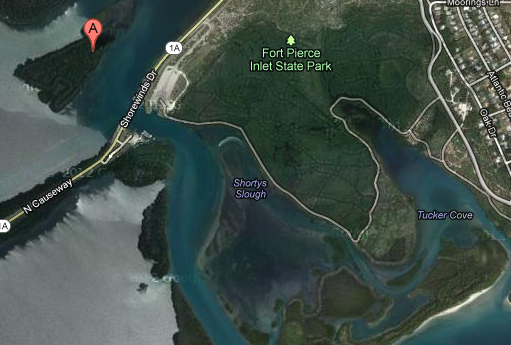
Here is the view of the land
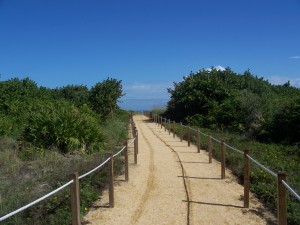
Fort Pierce Inlet State Park, a 340-acre part of the Florida State Park system, is located just north of the Fort Pierce Inlet, on North Hutchinson Island, near Fort Pierce.
Source
Fort Pierce Inlet is a place of natural beauty. And has a lot of thick brush which a Beast of good size could easily disappear into, but in my opinion this area is has too much traffic passing through. It is a tourist hot spot and also very popular with walkers as it is a place of beauty where one can feel at one with nature. With this much traffic passing through and the fact it has a very popular motorized kayak hire place called "Motorized Kayak Adventures" on the west side of it. So i do not think a Bigfoot could stay here without detection, although it is a huge area, I think it is far too much human traffic passing through.
Now lets head to the North side of Mangrove Island.
To the North there is a huge woodland area called Pepper Beach State Recreation Area.
Pepper Beach State Recreation Area
Here is an aerial view

Here is a view to get an insight of what its like on the ground

This area is much the same as Fort Pierce Inlet.It has a high amount of foot traffic as it is another popular hiker and tourist location in the Florida keys due to its untouched nature. But you can see from the pictures that it is very thick and dense with a lot of water tributaries so you could hide there for a while, but i find it very unlikely that a Large Primate could survive here without detection there is just too much people passing through for one never to have been reported here and to add to that when you are hiking your not just stomping straight ahead, you look around and explore your surroundings. So for none to have been detected here i find that very unlikely.
So could a large Primate live in any one of these locations and avoid detection by humans?.. I find it very unlikely. The only one where one could avoid detection is Mangrove Island but i find that this location is too small to support large Primates. As for Pepper Beach it is my opinion that looking at what i have found out it has far too much human traffic for some-one not to stumble across one of these Beasts. The same is to be said for Fort Pierce Inlet State Park.
Now lets address the food situation in these locations.
Mangrove Island
Mangrove Island has a lot of food on it. It is stacked with Mangrove trees which produce fruit and seeds that last for a long time as i stated earlier in the post. But there is also an array of swamp vegetation that a large Primate could eat. As for meat and protein there is a lot of fish in the water on the island and in the surrounding sea. The only problem on this small island as that the vast majority of water is salt water. There is not much fresh water on the island. There would be enough to drink but there is other ways a Primate can get fluids in there diet other than drinking. There is plenty fluids to be found in types of plants and vegetation. Also water can gather in tree hollows.
Water sometimes gathers in tree crotches or rock crevices. Use the above procedures to get the water. In arid areas, bird droppings around a crack in the rocks may indicate water in or near the crack.
Source
Which is probably the most likely source of water if a large Primate was on this island. So is there a good enough supply of water and food to support a large primates on the island ? Yes there is an abundance of all different types of food and a good enough supply of water to sustain one. As we know from research on large Primates such as gorillas they do not need a lot of water as they get most of there water supply from plants. ( see quote on previous post )
Now onto the next two locations.
Fort Pierce Inlet and Pepper Beach State Recreation Area
These two locations are in the same boat as Mangrove Island they have an abundance of vegetation and Mangrove trees so they have a steady supply of food along with the vast numbers of fish in the area a food supplies is not an issue. Also they have a slightly better water supply than Mangrove Island though with some large pools of fresh water. So there is enough resources in these areas to sustain large Primates.
I did not go into detail of altitudes and such on this investigation as there was no need, as all of these areas are flat lying easily inhabitable areas. I will go into detail on this in future investigations in the Hills.
Summary of Sighting Two
Sighting two had a lot more detail than the first sighting but some of the details were a little bit suspect to say the least. Although it was an unbelievable sighting it did provide a clear area in Florida Keys for investigation.
So could a Large Primate be sustained on Mangrove Island and avoid detection? Well No.. and here is why. Although there is enough food and water to support them the fact is it simply not big enough. These are large Primates, the one reported was 3ft tall and a juvenile. So wouldn't there have to be Larger ones. I have no reason to believe they could live on such a small island without traces of them being found.
So could a large Primate be sustained and avoid detection at Fort Pierce Inlet ? Well one could be sustained rather easily. Food is readily available in this area and there is a lot of fresh water but there is too much human traffic. One could live here but there is no way one could avoid detection in this location. To simplify, there is just too much people here for them to live in peace.
So could Pepper Beach State Recreation Area support a large Primate and hide it from detection ? Well this case is similar to the above location, plenty of food, plenty of water but too much people for one to remain hidden for so long in this location.
To sum up. I do not believe a Bigfoot or other large Primate could remain hidden in the Florida Keys, although there is plenty of food and fresh water for one there is just too many people passing through these areas.
edit on 1-2-2013 by Snoopie because: Adding content
I will be looking at reported sightings in the state of washington.
I will be using the Bigfoot Field Researchers orginizations website for the sighting listings BFRO
the BFRO has 3 types of sightings listed, however I will be only using the Visual sighting reports.
Washington
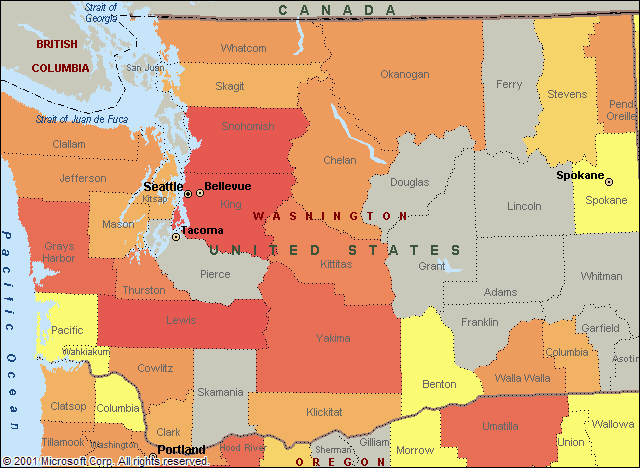
BFRO lists 544 sightings for the state of washington, I am going to start in yakima county with 22 reports, I will exclude all reports that are not visual sightings.
Report 1
Location: yakima county
Location: Cowiche Wilderness area
Date: Aug: 21
year: 2011
basic sighting details : lone hunter claims to have seen a creature standing near a fallen tree in the early morning hours..
report does not give a good location, only a general area.
This area is part of the Oak Creek wildlife area it is about a 5,000 acres section of the 42,000 acre wildlife area
area has several hiking trails thru it and supports large game, such as elk and deer.
source
Area shows to have an ample food and water source that would support a creature.
with the area being a popular hiking area, would expect sightings to be early or late in the day, due to foot traffic in the area..
Summary of Sighting One
report did not give a good location, so I had to work out details from the general area.
large and small game in the area would be a food source for a creature of this type. there are abundant numbers of game.
Water supplies in this area, rivers, and streams nearby.
Hikers in some areas..
I feel that this area could indeed support this type of creature, but feel any sightings would be limited due to human traffic in the area..
I will be using the Bigfoot Field Researchers orginizations website for the sighting listings BFRO
the BFRO has 3 types of sightings listed, however I will be only using the Visual sighting reports.
Washington

BFRO lists 544 sightings for the state of washington, I am going to start in yakima county with 22 reports, I will exclude all reports that are not visual sightings.
Report 1
Location: yakima county
Location: Cowiche Wilderness area
Date: Aug: 21
year: 2011
basic sighting details : lone hunter claims to have seen a creature standing near a fallen tree in the early morning hours..
report does not give a good location, only a general area.
This area is part of the Oak Creek wildlife area it is about a 5,000 acres section of the 42,000 acre wildlife area
area has several hiking trails thru it and supports large game, such as elk and deer.
Oak Creek has steep, rocky slopes, a rolling series of ridges and canyons, and over 90 miles of linear stream waterfront. Perennial streams include Oak Creek, Rattlesnake and Little Rattlesnake Creeks, and the South Fork of Cowiche Creek. These streams flow into the Naches and Tieton rivers, large subbasins in the Upper Yakima River watershed that support endangered salmonids, including bull trout
Wildlife use is diverse including Rocky Mountain elk, mule deer, California big horn sheep, sage grouse (incidental), forest grouse, turkey, quail, wood duck, and a myriad of small mammals, neo-tropical/upland birds, raptors, reptiles, and amphibians
source
Area shows to have an ample food and water source that would support a creature.
with the area being a popular hiking area, would expect sightings to be early or late in the day, due to foot traffic in the area..
Summary of Sighting One
report did not give a good location, so I had to work out details from the general area.
large and small game in the area would be a food source for a creature of this type. there are abundant numbers of game.
Water supplies in this area, rivers, and streams nearby.
Hikers in some areas..
I feel that this area could indeed support this type of creature, but feel any sightings would be limited due to human traffic in the area..
Washington
Sighting # 2
Washington state
Yakima County
Location: withheld
Nearest town: Naches
Nearest road: Hwy 410
Date: Aug 2007
Basic sighting details: BFRO research team, observed creature with thermal device.
Report witholds the location of the sighting, just giving a general area.
An area called Chinook pass

The pass provides the east entrance to Mount Rainier National Park, and carries State Route 410 between the towns of Enumclaw and Naches. Because of the high elevation, Chinook Pass is usually closed in November due to very heavy snow and significant avalanche danger. It usually opens in mid May and is not uncommon to have a snow depth at the summit of up to 15-feet
the sighting location is at about 3500 ft elevationaccording to the BFRO report.
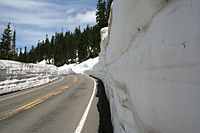
Photo above is of Chinook pass in the month of june.
In this area is the Jones wildlife area, home to deer,elk, big horn sheep and small game, this game extends the entire region
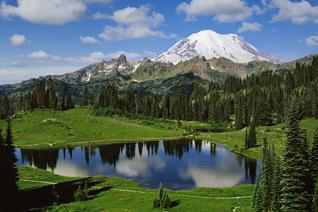
Water is found all over this area, in run off ponds, stream, as well as the Naches River
Summary of sighting 2
Without a better idea of the location, one can only investigate the general area of chinook pass.
Chinook Pass is a remote wilderness area, of high elevation, covered in deep snow many months of the year.
The snow limits the number of human visitors, allowing access only when the pass is open.
The area would seem to have ample food source to sustain a creature in regards to wildlife, however any foraging would be hindered by snow.
The area would seem to have ample water source to sustain a creature, with the many ponds, creeks, and rivers.
I feel that this area COULD support a creature, it's remote rugged area would limited the number of sightings.
More info on location could have provided much better results..
BFRO report
Sighting # 2
Washington state
Yakima County
Location: withheld
Nearest town: Naches
Nearest road: Hwy 410
Date: Aug 2007
Basic sighting details: BFRO research team, observed creature with thermal device.
Report witholds the location of the sighting, just giving a general area.
An area called Chinook pass

The pass provides the east entrance to Mount Rainier National Park, and carries State Route 410 between the towns of Enumclaw and Naches. Because of the high elevation, Chinook Pass is usually closed in November due to very heavy snow and significant avalanche danger. It usually opens in mid May and is not uncommon to have a snow depth at the summit of up to 15-feet
the sighting location is at about 3500 ft elevationaccording to the BFRO report.

Photo above is of Chinook pass in the month of june.
In this area is the Jones wildlife area, home to deer,elk, big horn sheep and small game, this game extends the entire region

Water is found all over this area, in run off ponds, stream, as well as the Naches River
Summary of sighting 2
Without a better idea of the location, one can only investigate the general area of chinook pass.
Chinook Pass is a remote wilderness area, of high elevation, covered in deep snow many months of the year.
The snow limits the number of human visitors, allowing access only when the pass is open.
The area would seem to have ample food source to sustain a creature in regards to wildlife, however any foraging would be hindered by snow.
The area would seem to have ample water source to sustain a creature, with the many ponds, creeks, and rivers.
I feel that this area COULD support a creature, it's remote rugged area would limited the number of sightings.
More info on location could have provided much better results..
BFRO report
edit on 14-2-2013 by okiecowboy because: content
This project is now closed due to inactivity from the project leader.
new topics
top topics
48
